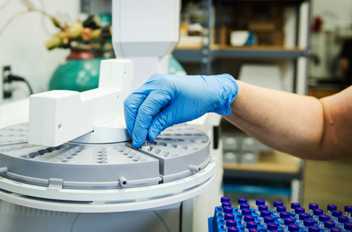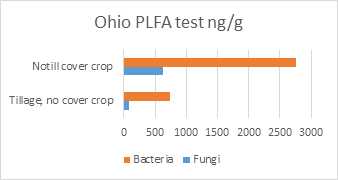A diverse and active pool of micro and macro organisms is essential for a healthy soil. While the soil biology plays a key role in building healthy soils, it can also provide nutrients to crops and naturally control some soil-borne pests and diseases. However, it is difficult to assess the soil biological properties in a lab compared to traditional chemical soil testing. Identifying and quantifying different soil organisms requires a range of sophisticated methods and instruments that most soil labs do not have. However, some labs offer a PLFA test that serves as a very good indicator of soil microbial communities.

This gas chromatograph machine can measure the phospholipid fatty acid (PFLA) content of a particular soil sample. (University of Missouri)
The PLFA test can provide a real-time snapshot of the soil microbial community. Soil microbes can effect functions such as plant growth, nutrient cycling and carbon sequestration. Changes in soil – altering processes such as tillage, cover crops, or manure application can be detected by the soil microbe reaction analyzed by the PLFA test. In this way, exact measurements of the type of soil microbe and total biomass of microbes can be determined and tracked as soil health changes over time.
Phospholipid fatty acid (PFLA) analysis Indicates the amount of microbial biomass and proportions of microbial types such as mycorrhizal fungi, gram positive fungi, gram negative fungi, actinomycetes, and saprophytic fungi. PLFA is a snapshot of community structure and abundance at the time of sampling. As environmental conditions such as pH, temperature, and moisture change so does the microbial community. These communities are also influenced by soil type, organic matter, intensity and type of tillage, crop rotations, cover crops, and herbicide or pesticide applications. The ability of microbial communities to change rapidly provides producers with a tool to compare agricultural management techniques with respect to overall better soil health and fertility. There is no baseline for biological testing as there is for chemical analysis. Therefore, this test is most useful in making comparisons between management conditions.

Here you can see increases in fungal-to-bacterial ratio under the long-term No till and cover crops. Also, total amount of bacteria and fungi increase with notill and cover crops. As the ratio of fungi to bacteria increases, the soil biome becomes more efficient in utilizing carbon and other nutrients and the soil therefore releases less CO2 to the atmosphere. Overall, there is much more activity in matured systems than some of the transitional or conventionally tilled systems. Managing soil to improve the health of its microbial life can provide strong carbon gains before the soil’s capacity levels off.
It is recommended to use the same laboratory for testing as each lab may use different fatty acids as key markers which will results in different values.
For more information: www.wardlab.com Ward Laboratory
https://cafnr.missouri.edu/soil-health/ University of Missouri
https://www.extension.purdue.edu/extmedia/AY/AY-366-W.pdf Purdue Extension







Post a comment
Report Abusive Comment